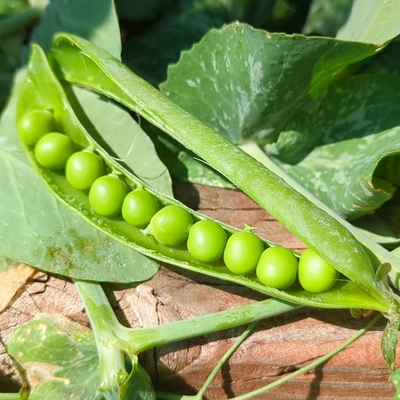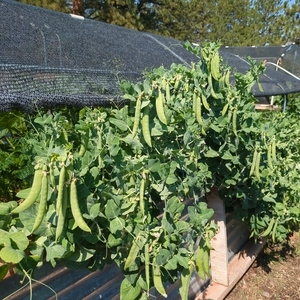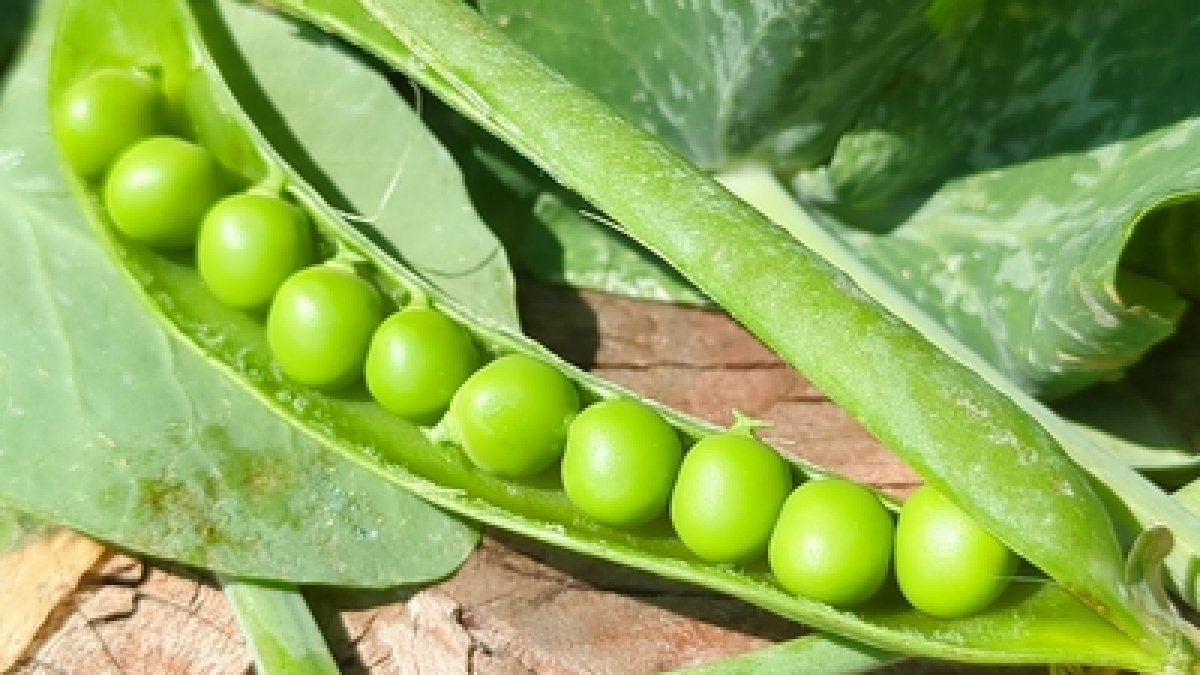PEAS

Peas of all kinds are always a nice treat. They grow nicely in our climate and shelled peas freeze well for eating all winter long. I typically grow a couple of beds of shelling peas and just a few sugar peas for snacking (usually while I’m in the garden) or snow peas for stir frys. I normally blanch & freeze the shelled peas in vacuum-sealed bags for use during the winter, or I freeze-dry them for longer-term storage.
Because of my unique garden arrangement with the tall raised beds topped with hoops for covering with shade cloth or plastic, I only grow varieties with short vines that do not need to be trellised. These peas that range 2-3 feet drape over the sides of the beds.
I’ve found that the peas grow best on the North sides of the beds, and I roll up the shade cloth half way to give them room to spread.

I typically sow the seeds outdoors in the ground during the first two weeks of May, and can begin harvesting late July to early August. Most of the peas advertise 60-65 days to maturity, but mine here are closer to 80 days.
Pea Seeds are easy to save for the next year’s garden. I usually select a few of the FIRST plants that grow the nicest looking peas, mark them so I won’t harvest them, and let them dry on the vines. After dried, I shell them and save them for next year!
2025 New Trial: In previous years I have harvested all the peas that were ready for that first harvest. Then I would throw the vines into compost. I’ve always seen some new growth starting at that time, but just didn’t want to deal with letting them grow out, and I hadn’t really found information about leaving them in the ground after that for another harvest. In 2025, I decided to leave the peas in the ground to see whether it would be worth letting them grow.
As it turned out, for my two rows of Maestro peas, I harvested 4.5 pounds of peas from the first harvest, and an additional 1.5 pounds from the second harvest in mid-September. Peas were weighed after shelling. The pea pods in the second harvest were not as nice: they were generally smaller with fewer peas per pod, and many pods were misshapen, curly or crooked. They also were ready for harvesting more gradually rather than all at once. But the peas were good!
Since I didn’t have another use for those beds after the first harvest, I have no reason not to leave them to grow. I’d say allowing them to grow for a second harvest was well worth it. In 2025 I also tried a new variety of pea: Canoe Peas. These were very nice, with generally 10 peas per pod. They were slower to harvest than the Maestro: they didn’t start until later and then took their time being ready just a few peas at a time rather than all at once. For this reason, I did not keep these growing for a second harvest.
HIGH ELEVATION GROWING TIP: PEAS
Grow lots of peas! Sow them in the ground 3-4 weeks before your average last frost and watch them grow.
PEA COMPANIONS
Companions for peas are bush beans, pole beans, carrots, celery, chicory, corn, cucumber, eggplant, parsley, early potato, radish, spinach, strawberry, sweet pepper, tomatoes and turnips. I typically plant my peas with either carrots, parsnips or beets.
In rows, the peas go along the edges of the beds with the carrots, parsnips or beets up the center. Since the peas dangle over the edge of our taller, raised beds, the beets & carrots are easy to reach. Alternatively, the peas can also grow in the center of the bed, trained to climb up to the top of our hoop, with the shorter root veggies along the outer edges.
FAVORITE PEA VARIETIES
Maestro OP – Shelling (60 Days) | DTH: 72-80, depending on when sown. Those sown later were harvested more quickly. Another winner, just a tad earlier to spread out the harvest when growing both varieites. Abundant harvests which continue August through September.
Canoe OP – Shelling (70 Days) | DTH: 80 Days. These were very nice with generally 10 peas per pod.
Green Arrow OP – Shelling (65 Days) | DTH: 80 | These grow nicely for me every year. Abundant harvests which continue August through September.
Cascadia OP – Sugar Snap Pea (60 Days) | 75 Days. These did not germinate well, but the few that did were very nice. Planted in succession I had nice snap pea treats throughout the last half of summer and after some fall freezes.
Oregon Sugar Pod II OP – Snow (70 Days) | DTH: 75-ish. Must pick these frequently to avoid peas that get too large!
LESS FAVORITE VARIETIES
Lincoln OP (67 Days) The year that I tried these they did not sprout well. I was disappointed with the small harvest.
PLS 560 OP (60 Days) One year I tried these peas, which are considered to be “bush-habited plants”. I thought it might be a good choice for my raised beds. I’ve read things like, “A strong-stemmed variety – it holds upright throughout the season, making harvest quick and very rewarding” to describe these peas. I found them more difficult to harvest: the stringy tendrils had a tendency to get the plants all twangled together and they did not stand so upright. The peas were fine, but not as plentiful, and I just didn’t care for these.
- Laurie
- Revised November 2025

